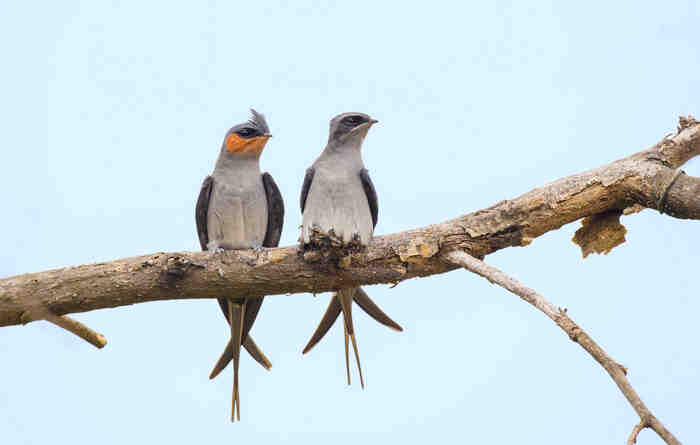Hemiprocne coronata
IUCN
LCBasic Information
Scientific classification
- name:Hemiprocne coronata
- Scientific Name:Hemiprocne coronata,Crested Treeswift,Crested Tree Swift
- Outline:Climbing birds
- Family:Apodidae
Vital signs
- length:17-33cm
- Weight:70-120g
- lifetime:About 15 years
Feature
It has a long crest on its head, shining with green luster, very beautiful and unique.
Distribution and Habitat
It is distributed in tropical areas of South Asia and Southeast Asia, such as India, Myanmar, Indochina, Indonesia, and the Solomon Islands. In my country, it is only distributed in Cangyuan, Jinghong, Mengyang, and Menglun in Yunnan. In addition, some people have seen it while sailing in the Taiwan Strait and along the coast of Shandong.
From deciduous sparse forests to evergreen forests, it mainly inhabits relatively open areas with trees, such as forest edges, secondary forests, orchards, and parks. At night, it often inhabits in groups, and sometimes inhabits individually.
Appearance
The male has a blue-grey upper body with green tinges. The head has a crest. The lower body, chin, throat and sides are chestnut. The breast is grey-blue, the abdomen is white, and the undertail coverts are white. The female is similar to the male, but the chin and throat are not chestnut.
The closely related swifts are very similar in appearance. Both sexes have a 2.5-3 cm long crest on their heads and usually stand upright when perched. The main difference between the two is the degree of black on the upper body and the length of the tail feathers. Unlike the swifts, the tail feathers of the crested swifts are far higher than the wing tips when the sickle wings are folded.
The crests of the small-whiskered and whiskered swifts are not obvious, but the facial markings are striking, with a striking white stripe above and below the eye socket. The small-whiskered swift has different habitat preferences than the other three species and is significantly smaller. Perhaps for this rea
Details
The Crested Treeswift is called Crested Treeswift in English. There are 6 subspecies in total, and only 1 subspecies is distributed in my country. The distribution range is very limited. It is a rare bird and is a second-level protected animal in my country.

None of the Crested Swifts are truly migratory; on the other hand, only the Whiskered Crested Swift is strictly sedentary, living within a nesting territory year-round. Other species are territorial during the breeding season and more gregarious during the winter, with up to 50 individuals recorded living in the same tree.
Crested Swifts are resident birds. They mainly live in relatively open areas with trees, such as forest edges, secondary forests, orchards, and parks. They often move in small groups, frequently flying in circles over open areas and forests, and sometimes over water surfaces such as rivers. Their food is mainly various flying insects such as mosquitoes and moths, and they can also prey while flying, but their flying time in the air is obviously less than that of other swifts, and their predation behavior is also different from that of other swifts. It does not fly in the air constantly to find food, but often rests on the top branches of the canopy. When insects and other food appear in the nearby space, it takes off to catch them. Because of its large body and long wings, it always spreads to both sides like a sickle in the air, just like a small airplane, sometimes flying low and sometimes taking off. At night, they often roost together in groups, and sometimes individually.
The sound of the crested swift: a chirping scream, especially when returning to the nest for the night. The chirping is usually louder than that of swifts.
The crested swift breeds from March to June and nests in rock caves and tree holes. The nest is made of moss and is tightly bonded together with saliva. Each nest lays 3 eggs. Its nest is extremely small and delicate, with a diameter of only 2.5-5 cm. It is cup-shaped or bag-shaped, mainly made of broken bark, small feathers and saliva. The structure is very tight and strong, and it is firmly fixed on the branch. The color of the nest is black with a few gray and dirty white spots. The appearance is very similar to the color of the branch. From the bottom, it looks like a small bag protruding from the branch. Each nest only produces one egg, which is light gray or grayish white, sometimes stained with blue, and is long and oval in shape. Its chicks are late-maturing and need to be carefully fed by their parents to grow up.
Listed as the second-level "National Key Wildlife Protection Animals in China".
Protect wild animals and eliminate game.
Maintaining ecological balance is everyone's responsibility!








